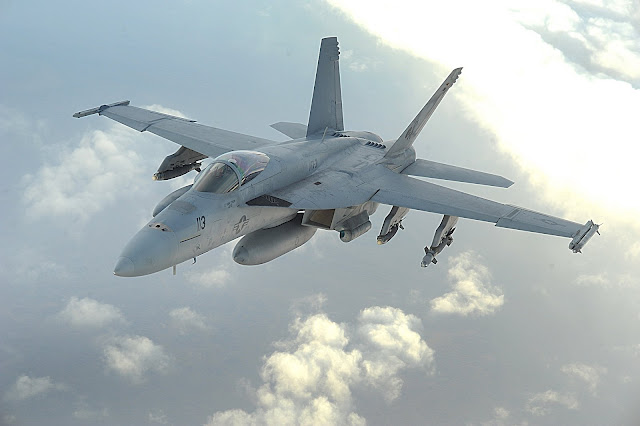The Boeing F/A-18E Super Hornet and related twin-seat F/A-18F are twin-engine carrier-capable multirole fighter aircraft variants based on the McDonnell Douglas F/A-18 Hornet. The F/A-18E single-seat and F/A-18F tandem-seat variants are larger and more advanced derivatives of the F/A-18C and D Hornet. The Super Hornet has an internal 20 mm M61 rotary cannon and can carry air-to-air missiles and air-to-surface weapons. Additional fuel can be carried in up to five external fuel tanks and the aircraft can be configured as an airborne tanker by adding an external air refueling system.
The Hornet and Super Hornet share many characteristics, including avionics, ejection seats, radar, armament, mission computer software, and maintenance/operating procedures.The Super Hornet is largely a new aircraft at about 20% larger, 7,000 lb (3,200 kg) heavier empty weight, and 15,000 lb (6,800 kg) heavier maximum weight than the original Hornet. The Super Hornet carries 33% more internal fuel, increasing mission range by 41% and endurance by 50% over the "Legacy" Hornet. The empty weight of the Super Hornet is about 11,000 lb (5,000 kg) less than that of the F-14 Tomcat which it replaced, while approaching, but not matching, the F-14's payload and range. As the Super Hornet is significantly heavier than the "legacy" Hornet, the catapult and arresting systems must be set differently. To aid safe flight operations and prevent confusion in radio calls, the Super Hornet is informally referred to as the "Rhino" to distinguish it from earlier Hornets. (The "Rhino" nickname was previously applied to the McDonnell Douglas F-4 Phantom II, which was retired from the fleet in 1987.)
The Super Hornet, unlike the previous Hornet, is designed so it can be equipped with an aerial refueling system (ARS) or "buddy store" for the refueling of other aircraft,filling the tactical airborne tanker role the Navy had lost with the retirement of the KA-6D and Lockheed S-3B Viking tankers. The ARS includes an external 330 US gal (1,200 L) tank with hose reel on the centerline, along with four external 480 US gal (1,800 L) tanks and internal tanks, for a total of 29,000 lb (13,000 kg) of fuel on the aircraft.On typical missions a fifth of the air wing is dedicated to the tanker role, which consumes aircraft fatigue life expectancy faster than other missions.
Initially, the Super Hornet's avionics and software had a 90% commonality with that of the F/A-18C/D fleet at the time.Differences include an up-front Touchscreen control display; a large multipurpose color liquid-crystal display; and a fuel display. The Super Hornet has a quadruplex digital fly-by-wire system, as well as a digital flight-control system that detects and corrects for battle damage.Initial production models used the APG-73 radar, later replaced by the AN/APG-79 active electronically scanned array (AESA). The AN/ASQ-228 ATFLIR (Advanced Targeting Forward Looking InfraRed), is the main electro-optical sensor and laser designator pod for the Super Hornet. The communications equipment consist of an AN/ARC-210 VHF/UHF radio and a MIDS low volume terminal for HAVE QUICK, SINCGARS and Link 16 connectivity.
compiled by XENOCIDE




No comments:
Post a Comment
PLEASE TELL YOUR VIEWS ABOUT THE ARTICLE